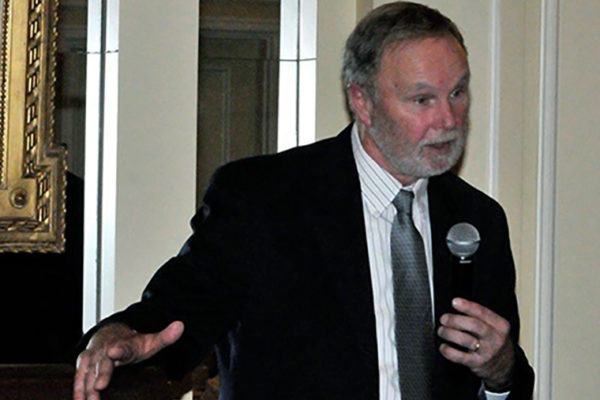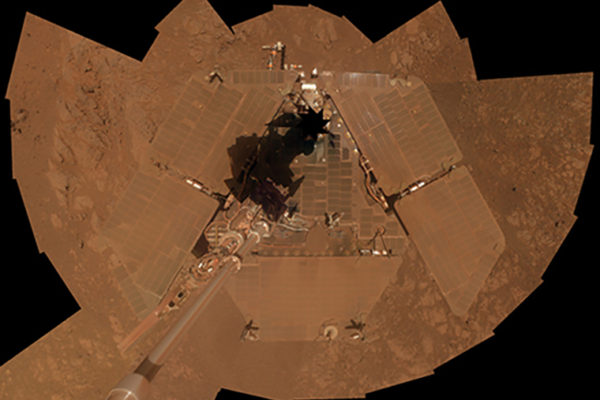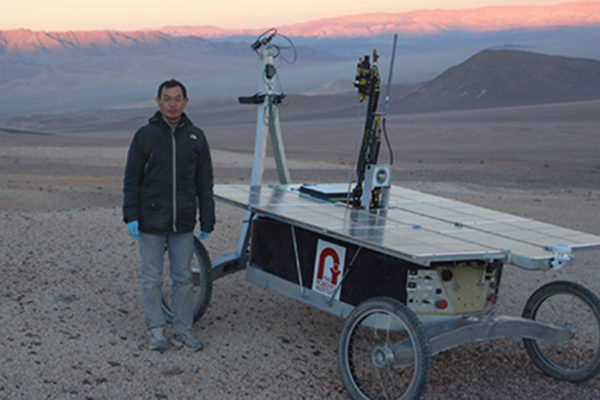Happy 10th anniversary Opportunity!
Ten years ago, on Jan. 24, 2004, the Opportunity rover landed on a flat plain in the southern highlands of the planet Mars and rolled into an impact crater scientists didn’t even know existed. In honor of the rover’s 10th anniversary, Ray Arvidson, PhD, deputy principal investigator of the rover mission, recently took an audience on a whirlwind tour of the rover’s decade-long adventures and discoveries.
NASA’s Opportunity at 10: new findings from old rover
In the Jan. 24 edition of the journal Science, Ray Arvidson, PhD, a professor at Washington University in St. Louis and deputy principal investigator of the MER mission to Mars, writes in detail about the discoveries made by the Opportunity rover and how these discoveries have shaped our knowledge of the planet.
Successful dry run for the 2020 Mars Mission
In June, a rover named Zoe
set out into the Atacama Desert on the west coast of South America to test a suite of instruments intended for future missions to Mars under Mars-like conditions. One of the instruments aboard Zoe was a Raman spectrometer designed by a team led by Alian Wang of Washington University in St. Louis. A fragile lab instrument that was ruggidized to survive the desert, the Raman spectrometer is expected to fly on the 2020 Mars mission.
WUSTL grads play key roles in NASA rover missions to Mars
Despite its midwest location, far away from massive
NASA mission control centers in Cape Canaveral, Fla., or Pasadena,
Calif., WUSTL can boast at least seven
graduates (and one current student) now making key contributions to
NASA’s latest mission to Mars, “Curiosity.”
Ray Arvidson offers updates on Mars rover missions
With all the fanfare about Mars rover Curiosity landing safely on the Red Planet on Aug. 6, it’s easy to forget that there’s already a rover on Mars — an older, smaller cousin set to accomplish a feat unprecedented in the history of Solar System exploration. WUSTL’s Raymond E. Arvidson is playing key roles in both Mars missions.
Sand-trapped Mars Rover makes big discovery, WUSTL researcher reports
NASA’s robotic rover Spirit, bogged down in the loose soil of a Red Planet crater for months, has helped make an important scientific discovery just by spinning its wheels. “We’ve found something supremely interesting in the disturbed soil,” says WUSTL’s Raymond Arvidson, deputy principal scientist on the mission. Sulfate minerals churned up by the rover’s wheels offer evidence that this area “could have once supported life,” he explains.
Mars as the Abode of Life?
Andrew H. Knoll, Ph.D., Fisher Professor of Natural History and professor of earth and planetary sciences at Harvard University, will discuss the evidence for life on Mars at 7 p.m. Oct. 30 in Room 300, Laboratory Sciences Building, on the Danforth Campus of Washington University in St. Louis.
Washington University faculty, students key to Phoenix Mars Mission
Image courtesy of NASAThe Phoenix Mars Lander on the northern Mars plains, searching for evidence of ice and water.Among the many Phoenix Mars Mission workers are Raymond E. Arvidson, Ph.D., the WUSTL chair of earth and planetary sciences, a computer specialist and four WUSTL students. Their goal is to infer from images and other data the geological history of the landing site and to imply some theories about current and past climate on Mars. Will they find ice?
Phoenix mission to Mars will search for climate clues
Raymond E. Arvidson, Ph.D., the James S. McDonnell Distinguished University Professor and chair of the earth and planetary sciences department in Arts & Sciences at Washington University in St. Louis, and a number of his student and personnel have major roles in the Phoenix mission to Mars. The space craft lands in the northern plains on May 25, 2008, and Arvidson is a key operations manager during the critical first week of operations. (Video available)
Mars database enhanced by new WUSTL software program
A software program developed by Washington University researchers is allowing viewers access to data and some early images from the most powerful spectral camera ever sent to Mars. The information is now available on NASA’s online planetary data archive.
View More Stories



